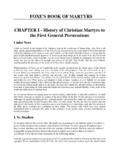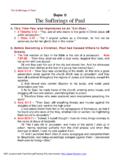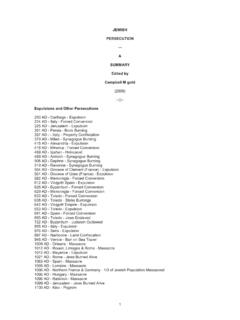Transcription of 271 Jewish GIs and Their Dog-Tags - Hakirah.org
1 271 Rabbi Akiva Males serves as the rabbi of Kesher Israel Congregation in Harrisburg, Pennsylvania. Jewish GIs and Their Dog-Tags By: AKIVA MALES My Father s Dog-Tag1 In May of 2012, my wife and I visited my parents in Cleveland, Ohio to help celebrate my father s birthday. As we all drove to a nearby park, I glanced at his keys in the ignition and noticed an item I had not seen for a few years the dog-tag on his key ring. During the Korean War, my father served in the US Air Force for four years (1951 1955). I grew up enthralled by the stories of his two years spent in Texas followed by another two years just outside Anchorage, Alaska. As a boy, I was particularly interested in one detail of my fa-ther s dog-tag, the letter H impressed on the tag s lower right-hand corner.
2 That H stood for Hebrew, the religious classifica-tion assigned to Jewish servicemen at that time. 1 I am greatly indebted to The Army Historical Foundation, and the office of the US Army s Chief Chaplain for answering many of my queries re-lating to the history of Dog-Tags and religious affiliation; Rabbi Dr. Jacob J. Schacter as well as H akirah s editorial staff for Their important com-ments on an earlier version of this article; and last but not least, my fa-ther, Mr. Males, for his invaluable editing assistance. akirah 15 2013272 : H akirah, the Flatbush Journal of Jewish Law and Thought As my interest in halakhah and US history increased, I learned that this simple H had been a source of great concern to many brave Jewish GIs during World War II.
3 History of the US Dog-Tag Dog-Tags are the nickname for the government-issued identifica-tion tags worn by all members of the US Armed Although Dog-Tags have become somewhat fashionable in popular culture, Their intended use is rather grim to ensure that the needs of seri-ously wounded soldiers are met, and that the remains of fallen sol-diers are properly identified. Surprisingly, the US did not begin issuing official identification tags to its troops until 1906. Prior to that time, the matter of identi-fying and providing vital information was left up to each individual In 1916, the US Army amended its previous regulations 2 Some maintain that the nickname stems from the identification tags commonly worn by people s pet dogs.
4 Others credit this nickname to the publishing magnate William Randolph Hearst. See < com/about_5212441_army-tags-called-dog-tags_html> for the following theory: The informal name for the ID tags used by soldiers, dog-tag, was coined by William Randolph Hearst in 1936. Hearst used the term in print as a reaction to the news that the Social Security Administra-tion was contemplating the use of such ID tags as means of identifica-tion for employees. As a staunch opponent of President Roosevelt, Hearst intended to undermine the campaign by lambasting this idea. The tags were never actually issued, but the name stuck and has been used to refer to the military ID tags ever since. 3 There are numerous US Civil War (1861 1865) accounts of both Union and Confederate soldiers pinning hand-written identification notes to Their clothing before marching into battle.
5 Private entrepreneurs soon realized that soldiers wanted forms of identification, and various ID medallions and pins were made to order for those soldiers who could afford to do so. It is little wonder that it is estimated that close to 42% of Civil War casualties were never properly identified. See A Short History of Identification Tags by Captain Richard W. Wooley, originally printed Jewish GIs and Their Dog-Tags : 273 and required that each serviceman be issued two identification tags. This way, in the event of a GI being killed in action, one tag would stay with and identify the body, while the other would be removed and delivered to the office charged with keeping track of records and burials. These two identification tags were to be worn by US servicemen at all times.
6 The vital information stamped on Dog-Tags evolved over For the purpose of this article, we focus on US Dog-Tags issued be-tween the years 1941 and 1952. All those tags contained the follow-ing personal information: 1) name 2) serial/service number5 3) date of most recent tetanus shots6 4) blood type 5) single letter denoting the serviceman s religious affiliation Until 1952, the following letters were used to describe the reli-gious affiliation of a US serviceman: P = Protestant C = Catholic in the Quartermaster Professional Bulletin, December 1988. The article is available online at: < >. 4 For example, in the early years of WWII the name and address of a ser-viceman s next-of-kin was also included.
7 5 In 1969, the US stopped using serial/service numbers for military record keeping and began using soldiers Social Security numbers instead. With identity theft becoming quite common in recent years, the military s cas-ual use of soldiers Social Security numbers has become a cause of grow-ing concern. See these two news stories about US servicemen/women and identity theft: < > and < .com/ >. 6 The military stopped including this piece of information in the early 1960s. I was unable to find an official reason for this change in military policy. 274 : H akirah, the Flatbush Journal of Jewish Law and Thought H = Hebrew ( Jewish )7 The first four items of personal and medical information were obviously vital for a soldier who was no longer able to speak for himself.
8 A serviceman s religious affiliation was included on his Dog-Tags so the US military could ensure that in the event of death, the wearer s religious needs might be properly met. If a soldier had no religious preference, no letter would have appeared at all. Jewish GIs and World War II During World War II, approximately 550,000 self-identified Jews served in the US Armed As per US military regulations, each of those Jewish soldiers/sailors/marines/airmen would have been issued Dog-Tags with the letter H stamped on them. While being identified as Jews may not have been a concern for those fighting the Japanese in the Pacific Theater, that one simple letter could have meant the difference between life and death for Jewish GIs serving in the European Theater.
9 After all, during WWII, the Nazis were on a maniacal campaign to murder all Jews. As such, Jewish American soldiers had good reason to fear being taken pris-oner by Nazi forces and identified as being 7 After 1952, the letter J was used instead of H on the Dog-Tags of Jew-ish US servicemen. (A member of my synagogue recently showed me his grandfather s WWII-era dog-tag with a J stamped on it. I cannot explain how any Dog-Tags from that period ended up with a J on them, rather than the regulation H .) Also in 1952, the Army introduced the letter X to designate other religious affiliations not covered under Protestant/Catholic/ Jewish faith groups, and the letter Y for those who did not have a religious preference.
10 In November of 1962, the Army stopped using religious codes, and decided that a soldier s religion was to be fully spelled out on Dog-Tags . Since then, the word Jewish appears on the Dog-Tags of all US soldiers/sailors/marines/ airmen choosing to iden-tify themselves as Jews. 8 < > 9 There are numerous reports of Jewish American prisoners of war who were singled out by the Nazis for execution or slave labor. See for exam- Jewish GIs and Their Dog-Tags : 275 Jewish GIs, fearful of being identified as such by Their Nazi cap-tors, were left with the following options: 1) Have no letter of religious preference stamped on Their Dog-Tags . 2) Make the H stamped on Their Dog-Tags illegible. 3) Discard Their Dog-Tags completely prior to being taken cap-tive. 4) Have a letter signifying a different religious preference stamped on Their Dog-Tags .








